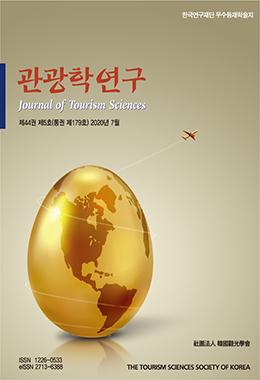관광이 지역 발전을 위한 유효한 수단으로 인식되면서, 지역관광의 중요성이 더욱 강조되고 있다. 지역의 관광 환경을 활성화기 위해서는 우선적으로 여행객들의 다목적지 여행 패턴에 대한 이해가 선행되어야 한다. 특히 관광객이 한 번의 여행을 통해서 하나의 이상의 도시를 방문하는 다목적지 여행의 비중이 꾸준히 증가하고 있다. 따라서 본 연구는 지리학에서 개발된 앵커 포인트 이론을 적용하여 여행객의 다목적지 여행을 통해서 방문한 관광목적지들 간의 위계적 구조를 파악하고 이러한 위계 구조를 결정하는 요인이 무엇인지를 조사했다. 이를 위해 문화체육관광부에서 실시한 “2016 국민 여행 실태 조사”의 원자료와 한국관광공사에서 2018년에 공개한 “관광 경쟁력 진단 및 분석”의 원자료를 이용하여, 사회연결망 분석기법과 상관분석 및 다중회귀분석을 실시했다. 연구결과는 다음과 같다. 첫째, 내향·외향 연결정도 중심성 분석결과, 해운대구는 내향과 외향 연결정도 모두에서 가장 높은 순위로 나타나 대한민국의 관광 목적지 가운데 앵커 포인트임을 확인했다. 둘째, 15개의 관광경쟁력 진단 핵심 지표에서 내향 연결정도 중심성과 관련해서는 관광숙박업객실 수가 유일하게 유의미한 요인이었지만, 외향 연결정도 중심성 점수와 관련해서는 유의미하게 관련되어진 변수가 도출되지 않았다. 이러한 분석 결과는, 여행객의 다목적지 여행 패턴을 이해하는 것과 관련하여 앵커 포인트 이론의 시사점을 확인할 수 있었고, 국토 공간에 산재해 있는 관광 목적지 간의 연결 관계의 특징 및 연결 관계를 결정하는데 유의미하게 관련되는 변수를 파악했다. 여행객의 다목적지 여행과 관련한 이론적 시사점과 함께, 지역관광 활성화를 위한 실무적 시사점 및 향후 연구 과제를 결론에서 제시했다.
Tourism has been recognized as a critical power for sound condition of regional economy. It is also essential to understand tourists’ multi-destination travel patterns for vitalizing regional tourism, since tourists tend to visit multi-destinations during their single trip. Applying Anchor-point Theory, this study investigated the determinants related to the ranks in tourism destination hierarchy, which was computed by social network analysis techniques, such as degree centrality. We used raw data of “2016 Korea National Tourism Survey” and “Regional Tourism Competitiveness Model Index,” conducted by Ministry of Culture, Sports, and Tourism of Korea and Korea National Tourism Organization, respectively. Data were analyzed using social network analysis, correlation analysis, and multiple regression analysis. Results revealed that Haeundae was the 1st-ranked tourist destination in both in-degree and out-degree networks, and confirmed to be the anchor-point among other tourist destinations. Meanwhile, out of fifteen tourism competitiveness indicators, only the number of tourism accommodations was significantly related to in-degree centrality scores (ranks), while no other indicators showed such relationships. The results hold several theoretical and practical implications regarding travelers’ multi-destination travel behaviors and the relationship between the characteristics of tourism destinations and multi-destination travel of travelers.


